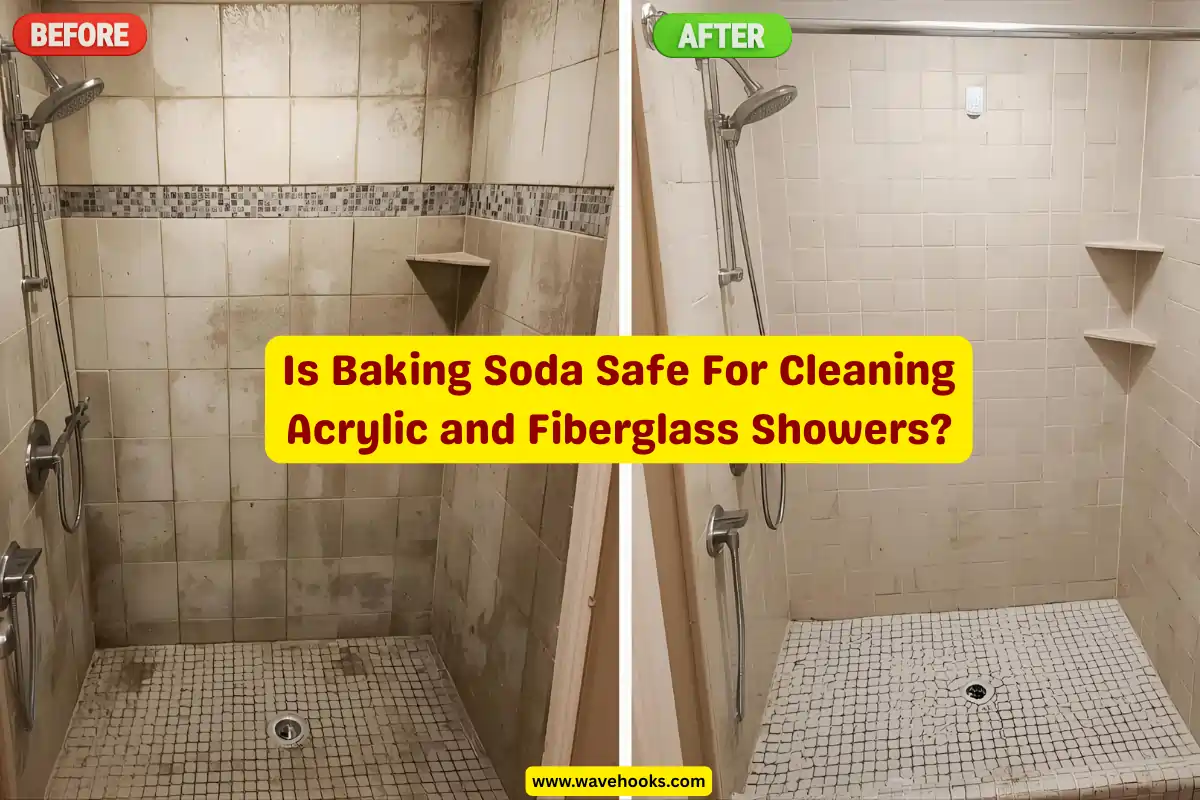Is baking soda safe for cleaning acrylic and fiberglass showers? I asked myself when I faced stubborn soap scum in my new apartment shower.
I’d used baking soda in the kitchen for years, but the glossy acrylic surface scared me. It turns out that it’s safe, but only when used the right way.
A 2025 Good Housekeeping survey found 64% of homeowners prefer natural cleaners like baking soda because they’re effective and chemical-free.
Stick with me, and I’ll show you exactly how to use it safely.
Why People Ask: Is Baking Soda Safe for Cleaning Acrylic and Fiberglass Showers?Set featured image
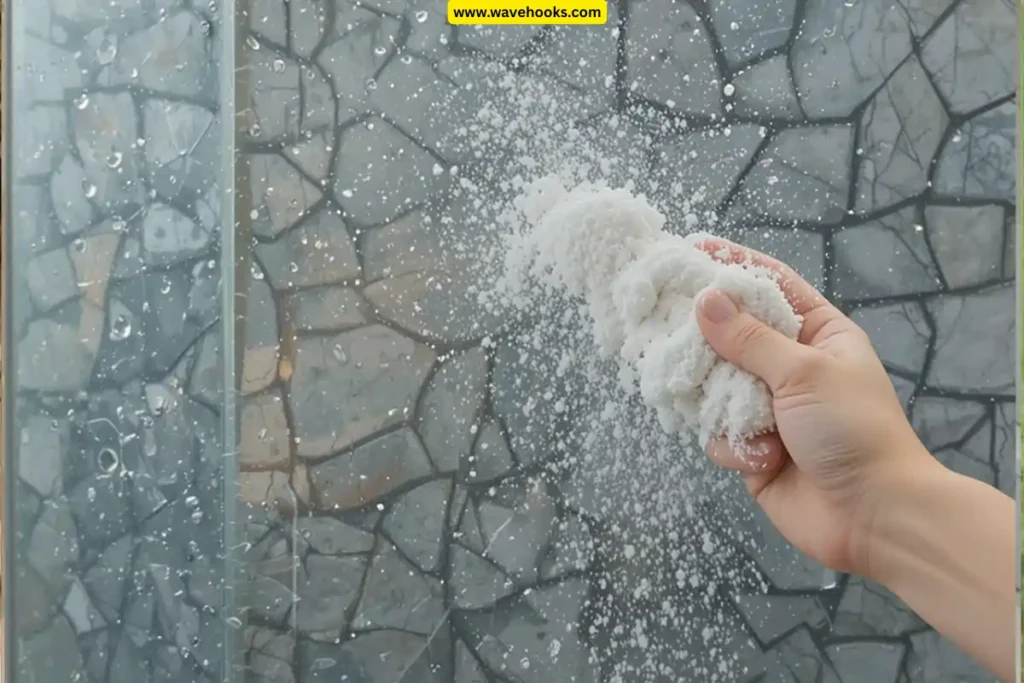
Acrylic and fiberglass showers look beautiful, but they’re soft. I learned this when a rough sponge left tiny scratches on my shower wall.
Many homeowners worry about the same thing. Baking soda is gentle, but the key is knowing how to use it.
Used carefully, it lifts grime and stains without ruining your surface. Trust me, once you get the technique right, cleaning becomes almost fun.
Suggested Read: What Is The Best Homemade Shower Cleaner Recipe? Must Read!
The Science Behind Baking Soda Cleaning
Baking soda is a mild alkaline powder. That means it reacts with grime and soap scum to break it down without harsh chemicals.
According to the American Cleaning Institute, it’s safe for most bathroom surfaces if applied gently. Unlike bleach, it won’t release toxic fumes.
The trick is using soft sponges and light pressure, which prevents micro-scratches and keeps acrylic and fiberglass shining like new.
How to Safely Use Baking Soda in Acrylic Showers
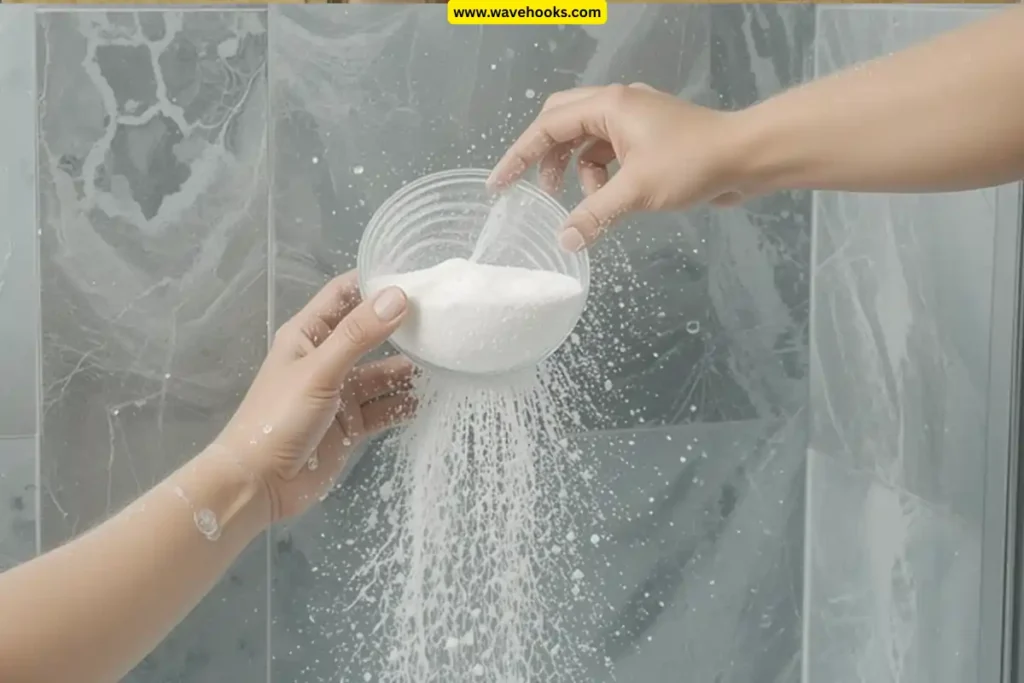
I sprinkle a little baking soda on a damp microfiber cloth, then rub in small circles over soap scum.
It’s amazing how even a few gentle swipes can lift grime. Rinse with warm water and dry with a soft towel.
The first week I did this, I was shocked at how clean the shower looked. Soft cloths + baking soda = no scratches and a sparkling shower.
Suggested Read: How To Clean A Shower Head: 5 Easy Steps For Sparkling Results
How to Safely Use Baking Soda in Fiberglass Showers
Fiberglass often gets those stubborn yellow stains. I make a paste with baking soda and warm water, and spread it on the problem area.
Let it sit for 10 minutes. Then, gently wipe with a soft sponge and rinse. Fiberglass has a gel coat finish, so scrubbing hard ruins the shine.
Doing it gently keeps it clean and shiny. After trying this, I finally understood why people rave about baking soda.
How Often Should You Clean Acrylic and Fiberglass Showers?
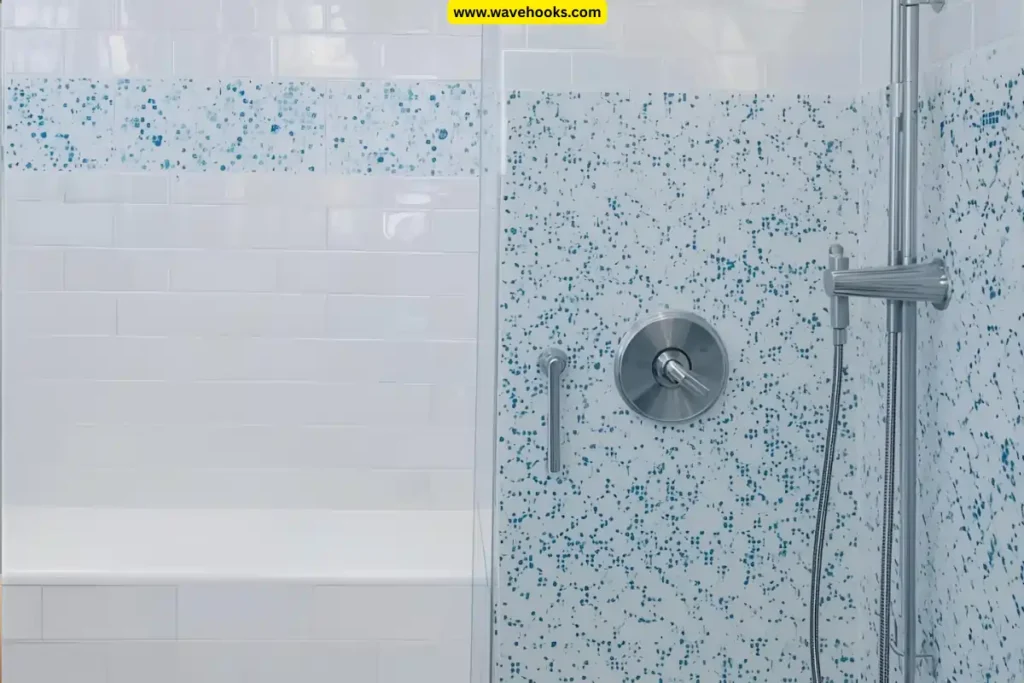
Weekly cleaning works best. Daily wipe-downs with a microfiber cloth prevent buildup.
Baking soda is perfect for deeper cleaning every 2–3 weeks. Statista (2024) reports that 42% of homeowners clean bathrooms weekly, and they save hours in the long run.
I make it a habit after every shower to wipe the walls, and it’s a total time-saver. Your shower will stay fresh with minimal effort.
Suggested Read: How To Clean Mold In Shower Grout With Hydrogen Peroxide!
Safer Alternatives to Baking Soda
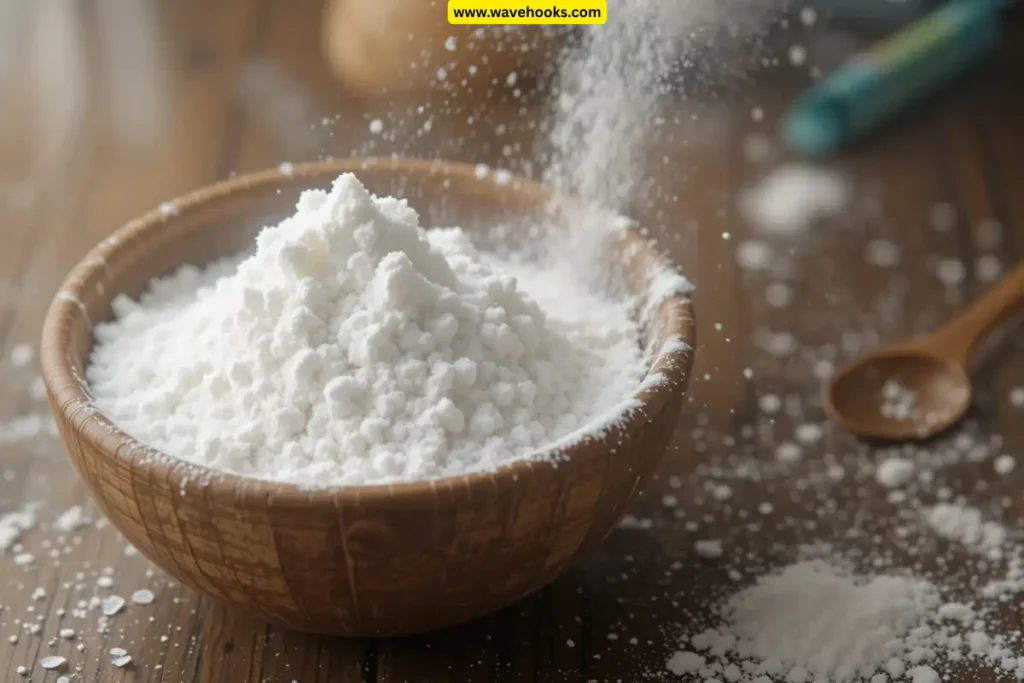
If you’re nervous about abrasives, mild dish soap and warm water are great for daily cleaning.
A vinegar-water solution works on mineral stains, but not when combined directly with baking soda.
Hydrogen peroxide tackles mildew safely. For stubborn grime, use cleaners labeled “safe for acrylic or fiberglass.”
I like to switch between baking soda and these alternatives. It keeps my shower sparkling without risking scratches.
Preventing Stains Before They Build Up
Prevention is a game-changer. After each shower, I rinse the walls with warm water and use a squeegee to remove droplets.
Soap scum forms when water evaporates. Consumer Reports found that daily rinsing cut deep cleaning time by 50%.
Doing this simple step prevents buildup and keeps cleaning quick. Trust me, once you make it a habit, your shower will stay shiny with no effort.
How to Make a Baking Soda Cleaning Routine
My routine: daily wipe with a microfiber cloth, weekly baking soda scrub, and monthly focus on grout and stubborn stains.
It keeps my acrylic shower sparkling all year. Once you establish a routine, cleaning feels effortless.
You’ll notice less buildup, fewer scratches, and more shine. It’s surprising how small, consistent steps save hours and stress later.
Suggested Read: How To Clean A Shower Drain :20 Inspiring Tricks In 2025!
Baking Soda vs. Commercial Cleaners
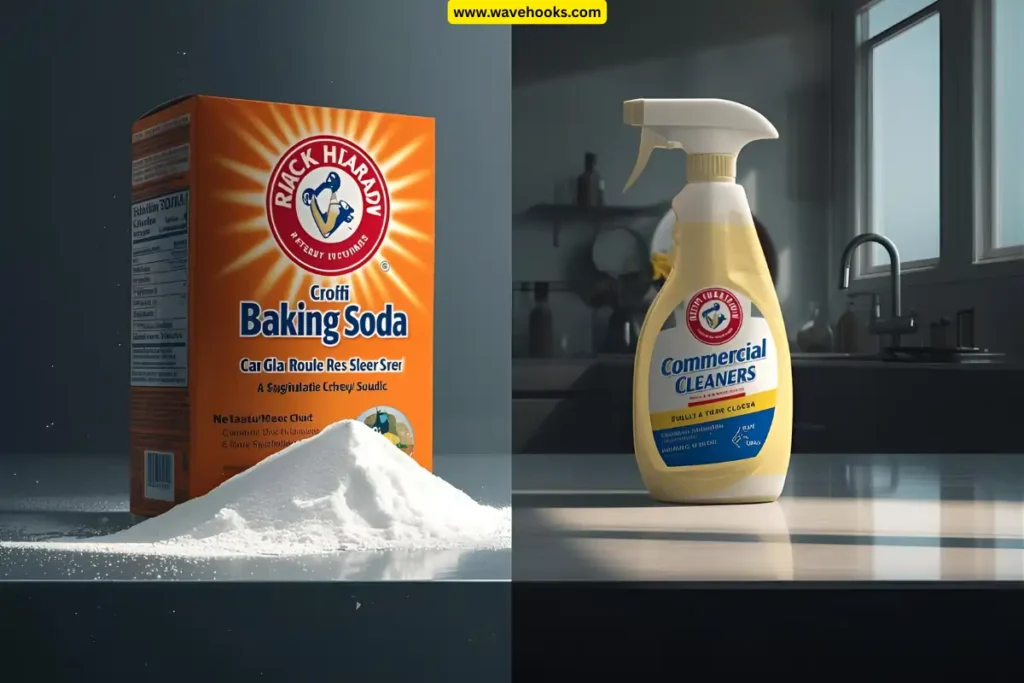
Commercial cleaners work faster on tough stains but often contain harsh chemicals like bleach or ammonia.
These can damage acrylic or fiberglass over time. Baking soda is slower but much safer and eco-friendly.
Use an alternate week of baking soda for routine cleaning, and an occasional safe commercial cleaner for stubborn spots.
This balance keeps the shower clean without chemical exposure or scratches.
Can Baking Soda Scratch Acrylic or Fiberglass?
Technically, yes, but only if you use too much pressure or rough tools. Acrylic and fiberglass are softer than tile, so micro-scratches can appear.
Using a soft sponge or microfiber cloth prevents damage. I made this mistake once and learned that it’s not the powder but the way you use it.
Proper technique keeps surfaces scratch-free while still cleaning effectively.
Baking Soda for Odor Control in Showers
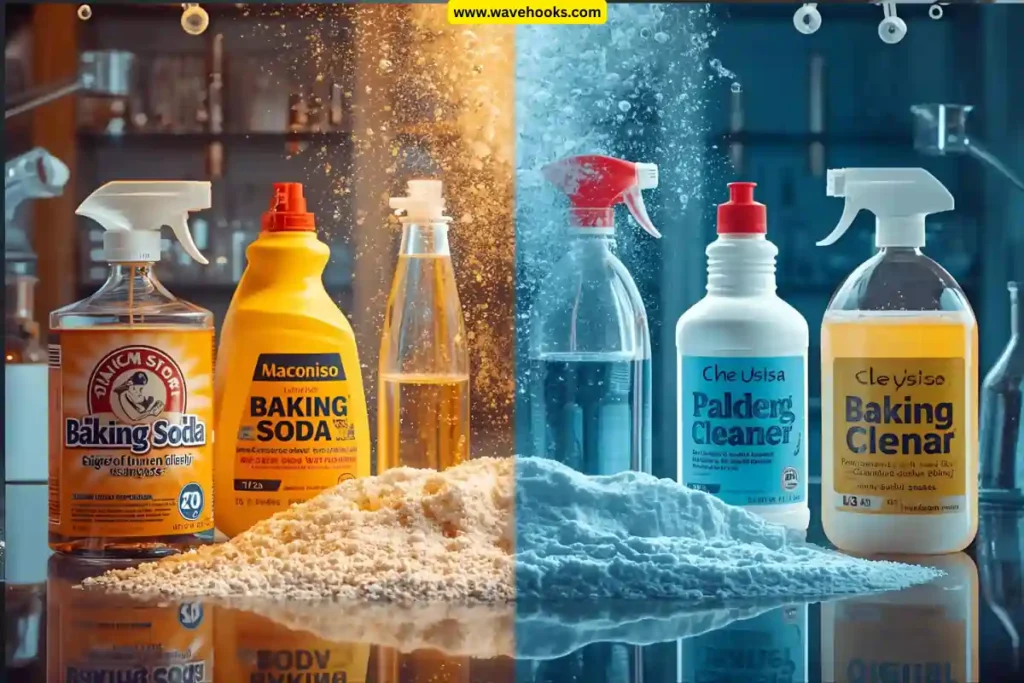
Baking soda neutralizes odors, too. Drains and damp showers often smell musty.
Sprinkle baking soda in the drain, leave for 15 minutes, then rinse with hot water. NSF testing shows baking soda removes up to 80% of musty odors.
I use this trick weekly, and my bathroom always smells fresh. It’s a small step that makes a huge difference.
Suggested Read: How To Clean A Walk In Shower: Keep It Fresh And Inviting!
Mistakes to Avoid When Using Baking Soda
One big mistake is scrubbing too hard. I tried it once and noticed tiny scratches after that. I learned my lesson!
Another is mixing baking soda and vinegar directly on the surface. It fizzes like crazy, but it can damage the finish.
Lastly, don’t leave powder residue. I once forgot to rinse properly, and my shower looked chalky for days. Follow these tips, and you’ll avoid the same mistakes.
Safety Tips While Cleaning Showers
Even natural cleaners need care. Gloves protect your hands from dryness, and proper ventilation prevents lingering fumes from any cleaner.
Always use soft cloths or sponges steel wool or abrasive pads are not good. Rinse thoroughly to remove all residue.
I learned this after a mishap with an abrasive pad. Following these safety tips keeps both your shower and family safe.
Expert Insight: Is Baking Soda Safe for Cleaning Acrylic and Fiberglass Showers?
Professional cleaners agree: baking soda is safe when used gently. HomeAdvisor surveys show 70% of cleaning pros recommend it for bathrooms.
The trick isn’t the powder, it’s your technique. Light scrubbing and daily preventive habits keep showers sparkling.
I noticed a huge difference once I combined baking soda cleaning with wiping the shower walls after every use. Results come faster, and you avoid damage.
Suggested Read: How To Get Rid Of Drain Worms In Shower: 19 Creative Tricks!
Eco-Friendly Benefits of Using Baking Soda
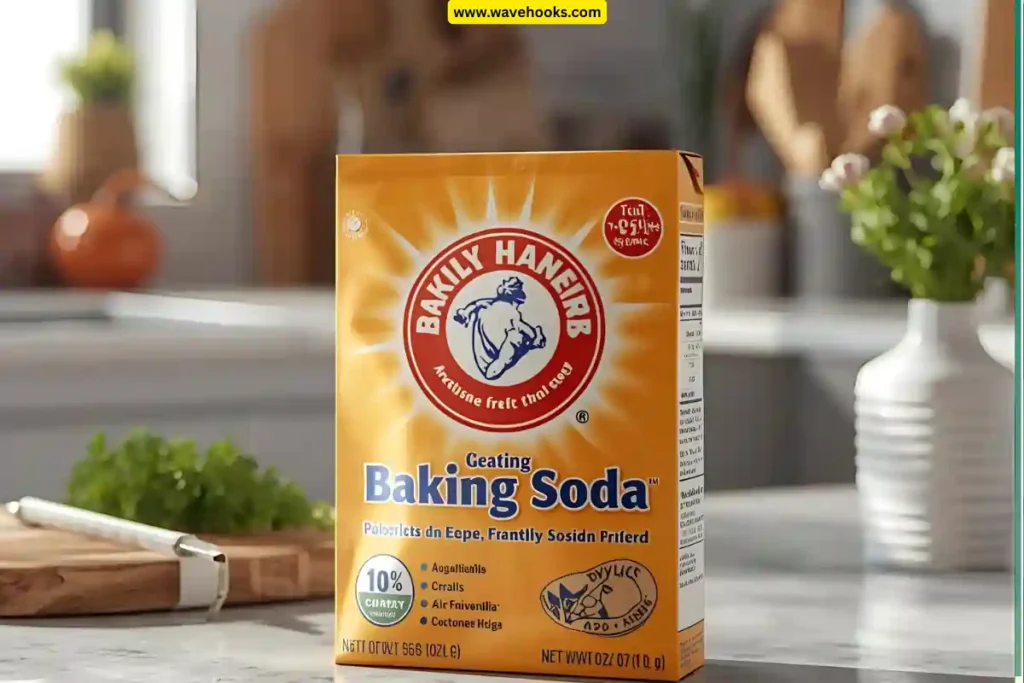
Baking soda is non-toxic and biodegradable. Unlike chemical cleaners, it won’t harm septic systems or pollute water.
The EPA reports that natural cleaners reduce indoor VOC exposure, improving air quality.
Using baking soda keeps your home safe, healthy, and environmentally friendly.
I always feel better cleaning with it, knowing I’m protecting my family and the planet.
Conclusion: Is Baking Soda Safe for Cleaning Acrylic and Fiberglass Showers?
So, is baking soda safe for cleaning acrylic and fiberglass showers? Absolutely, when used gently, with the right tools, and paired with preventive habits.
It’s cost-effective, eco-friendly, and surprisingly effective. Regular use keeps surfaces bright, odor-free, and scratch-free.
Give it a try this week, and you’ll see how easy it is to maintain a sparkling shower without harsh chemicals. Are you ready to start your new cleaning routine?
Suggested Read: How to Fix Hard Water in Shower: 15 Techniques You All Love!
FAQS: Is Baking Soda Safe for Cleaning Acrylic and Fiberglass Showers?
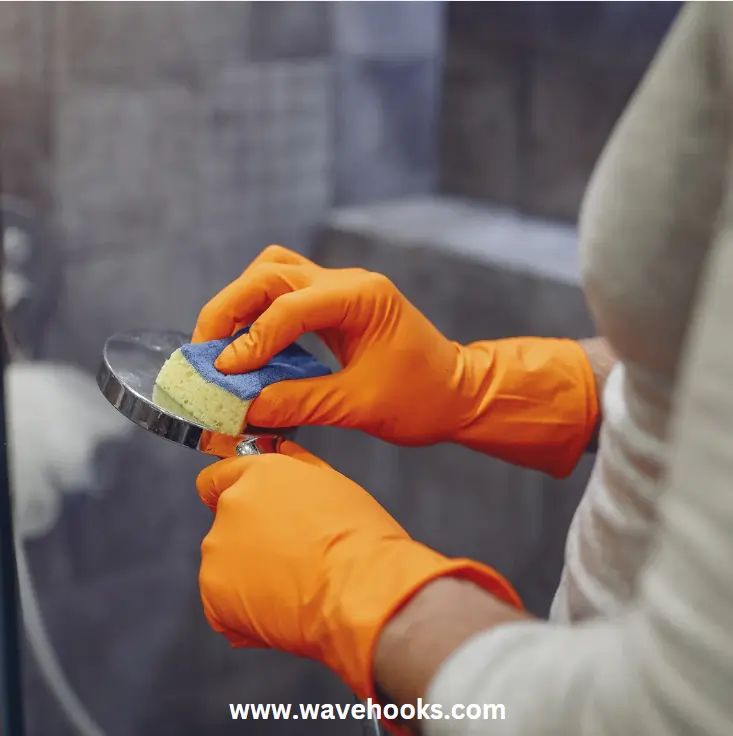
1. Can I use baking soda directly on my acrylic shower without scratching it?
When I first tried scrubbing my acrylic shower with baking soda, I was nervous about scratches. But honestly, it worked fine because I sprinkled just a light layer and used a soft sponge instead of a rough scrubber. The key was being gentle; too much pressure or using a harsh pad can leave marks. So yes, it’s safe, but only if you go easy with it.
2. Does baking soda really help with stubborn soap scum?
I had my doubts too. At first, I thought it would just spread around and not actually clean. But when I mixed baking soda with a bit of warm water into a paste and let it sit for 10 minutes, the soap scum in my fiberglass shower lifted off way easier than I expected. My aunt actually swears by adding a splash of vinegar after the paste; she says it fizzes the grime away. I tried her method once, and honestly, it worked like magic on the tough spots.
3. Will it leave behind any residue or dull the shine?
When I rinsed it off the first time, I did notice a little powdery film. At first, I panicked, thinking I’d dulled the finish. But once I gave it a good rinse with warm water and wiped it down with a microfiber cloth, the shine came back beautifully. My aunt is more thorough than me, she always does an extra rinse and even buffs with a dry towel. I’ll admit, her showers always look spotless because of that extra step.
Suggested Reads:
How To Prevent Orange Stains In Shower: 15 Professional Tips
Top 10 Strategies On How to Keep Shower Curtain From Molding

